TPMS TOYOTA HIGHLANDER HYBRID 2020 Warranties & Maintenance Guides (in English)
[x] Cancel search | Manufacturer: TOYOTA, Model Year: 2020, Model line: HIGHLANDER HYBRID, Model: TOYOTA HIGHLANDER HYBRID 2020Pages: 260, PDF Size: 8.54 MB
Page 13 of 260
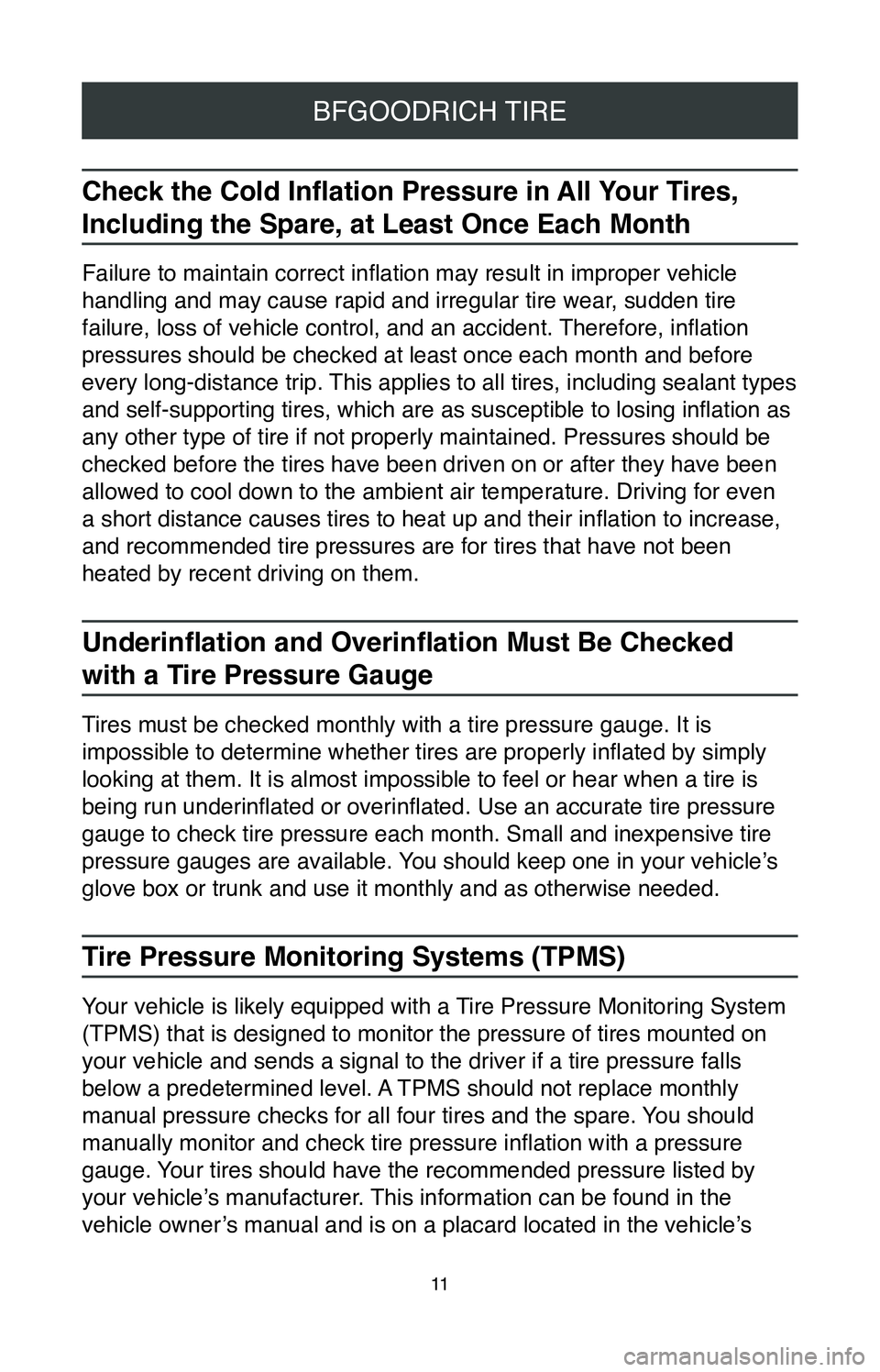
11
BFGOODRICH TIRE
Check the Cold Inflation Pressure in All Your Tires,
Including the Spare, at Least Once Each Month
Failure to maintain correct inflation may result in improper vehicle
handling and may cause rapid and irregular tire wear, sudden tire
failure, loss of vehicle control, and an accident. Therefore, inflation
pressures should be checked at least once each month and before
every long-distance trip. This applies to all tires, including sealant types
and self-supporting tires, which are as susceptible to losing inflation as
any other type of tire if not properly maintained. Pressures should be
checked before the tires have been driven on or after they have been
allowed to cool down to the ambient air temperature. Driving for even
a short distance causes tires to heat up and their inflation to increase,
and recommended tire pressures are for tires that have not been
heated by recent driving on them.
Underinflation and Overinflation Must Be Checked
with a Tire Pressure Gauge
Tires must be checked monthly with a tire pressure gauge. It is
impossible to determine whether tires are properly inflated by simply
looking at them. It is almost impossible to feel or hear when a tire is \
being run underinflated or overinflated. Use an accurate tire pressure
gauge to check tire pressure each month. Small and inexpensive tire
pressure gauges are available. You should keep one in your vehicle’s
glove box or trunk and use it monthly and as otherwise needed.
Tire Pressure Monitoring Systems (TPMS)
Your vehicle is likely equipped with a Tire Pressure Monitoring System
(TPMS) that is designed to monitor the pressure of tires mounted on
your vehicle and sends a signal to the driver if a tire pressure falls
below a predetermined level. A TPMS should not replace monthly
manual pressure checks for all four tires and the spare. You should
manually monitor and check tire pressure inflation with a pressure
gauge. Your tires should have the recommended pressure listed by
your vehicle’s manufacturer. This information can be found in the
vehicle owner’s manual and is on a placard located in the vehicle’s
Page 14 of 260
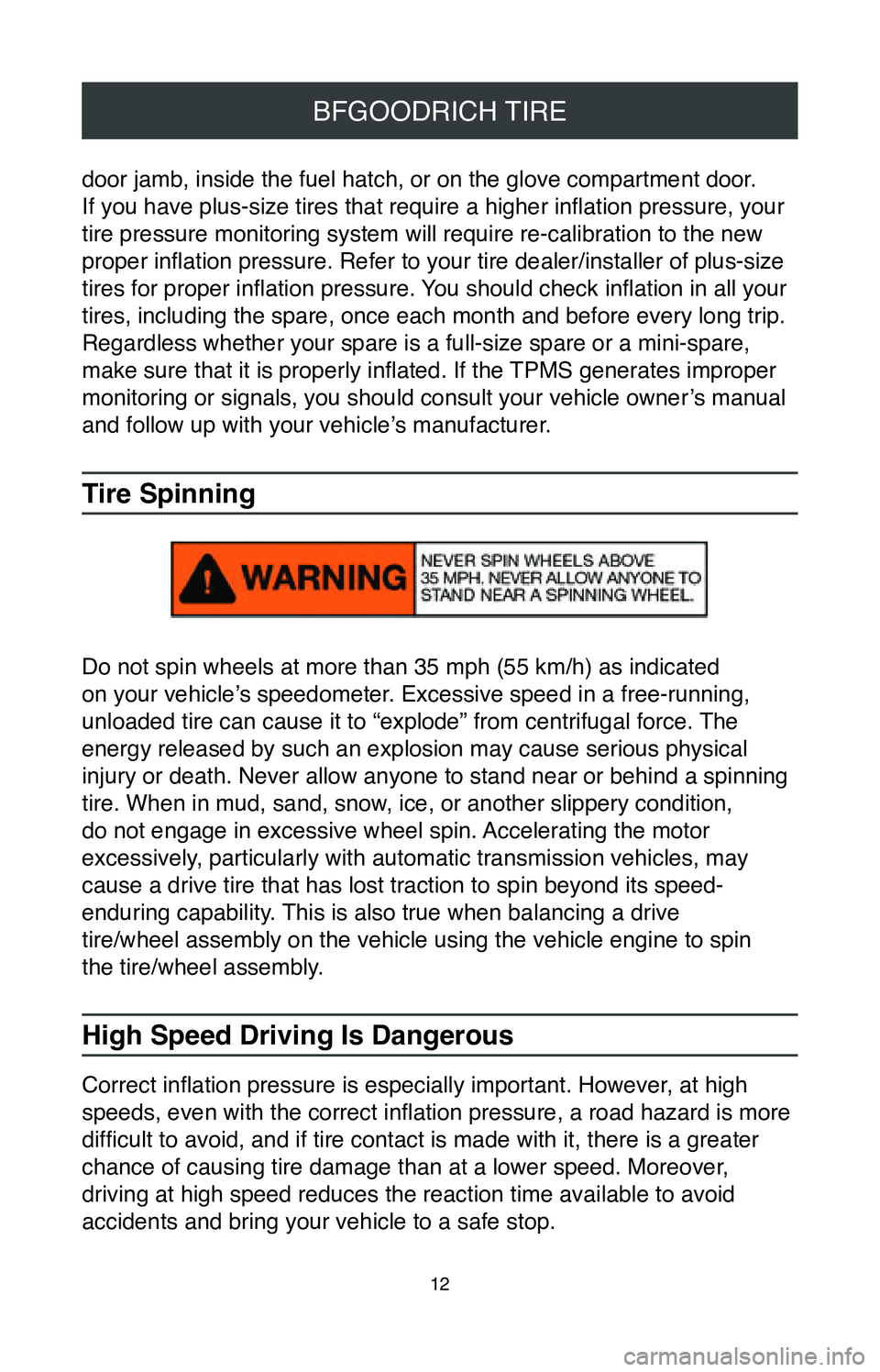
12
BFGOODRICH TIRE
door jamb, inside the fuel hatch, or on the glove compartment door.
If you have plus-size tires that require a higher inflation pressure, your
tire pressure monitoring system will require re-calibration to the new
proper inflation pressure. Refer to your tire dealer/installer of plus-size
tires for proper inflation pressure. You should check inflation in all your
tires, including the spare, once each month and before every long trip. \
Regardless whether your spare is a full-size spare or a mini-spare,
make sure that it is properly inflated. If the TPMS generates improper
monitoring or signals, you should consult your vehicle owner’s manual
and follow up with your vehicle’s manufacturer.
Tire Spinning
Do not spin wheels at more than 35 mph (55 km/h) as indicated
on your vehicle’s speedometer. Excessive speed in a free-running,
unloaded tire can cause it to “explode” from centrifugal force. The
energy released by such an explosion may cause serious physical
injury or death. Never allow anyone to stand near or behind a spinning
tire. When in mud, sand, snow, ice, or another slippery condition,
do not engage in excessive wheel spin. Accelerating the motor
excessively, particularly with automatic transmission vehicles, may
cause a drive tire that has lost traction to spin beyond its speed-
enduring capability. This is also true when balancing a drive
tire/wheel assembly on the vehicle using the vehicle engine to spin
the tire/wheel assembly.
High Speed Driving Is Dangerous
Correct inflation pressure is especially important. However, at high
speeds, even with the correct inflation pressure, a road hazard is more
difficult to avoid, and if tire contact is made with it, there is a greater
chance of causing tire damage than at a lower speed. Moreover,
driving at high speed reduces the reaction time available to avoid
accidents and bring your vehicle to a safe stop.
Page 22 of 260
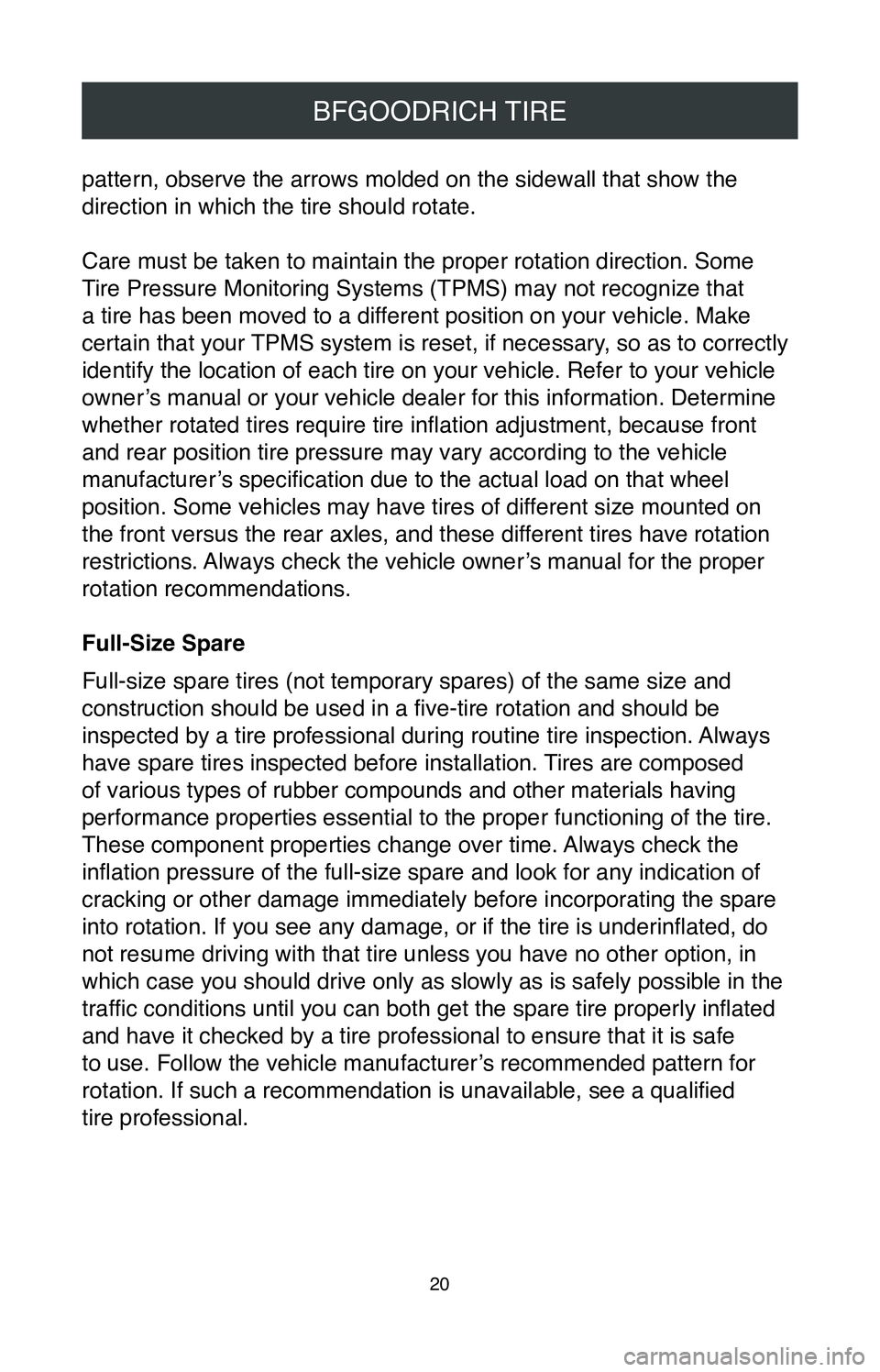
20
BFGOODRICH TIRE
pattern, observe the arrows molded on the sidewall that show the
direction in which the tire should rotate.
Care must be taken to maintain the proper rotation direction. Some
Tire Pressure Monitoring Systems (TPMS) may not recognize that
a tire has been moved to a different position on your vehicle. Make
certain that your TPMS system is reset, if necessary, so as to correctly
identify the location of each tire on your vehicle. Refer to your vehicl\
e
owner’s manual or your vehicle dealer for this information. Determine
whether rotated tires require tire inflation adjustment, because front
and rear position tire pressure may vary according to the vehicle
manufacturer’s specification due to the actual load on that wheel
position. Some vehicles may have tires of different size mounted on
the front versus the rear axles, and these different tires have rotation
restrictions. Always check the vehicle owner’s manual for the proper
rotation recommendations.
Full-Size Spare
Full-size spare tires (not temporary spares) of the same size and
construction should be used in a five-tire rotation and should be
inspected by a tire professional during routine tire inspection. Always
have spare tires inspected before installation. Tires are composed
of various types of rubber compounds and other materials having
performance properties essential to the proper functioning of the tire. \
These component properties change over time. Always check the
inflation pressure of the full-size spare and look for any indication of
cracking or other damage immediately before incorporating the spare
into rotation. If you see any damage, or if the tire is underinflated, do
not resume driving with that tire unless you have no other option, in
which case you should drive only as slowly as is safely possible in the \
traffic conditions until you can both get the spare tire properly inflated
and have it checked by a tire professional to ensure that it is safe
to use. Follow the vehicle manufacturer’s recommended pattern for
rotation. If such a recommendation is unavailable, see a qualified
tire professional.
Page 50 of 260
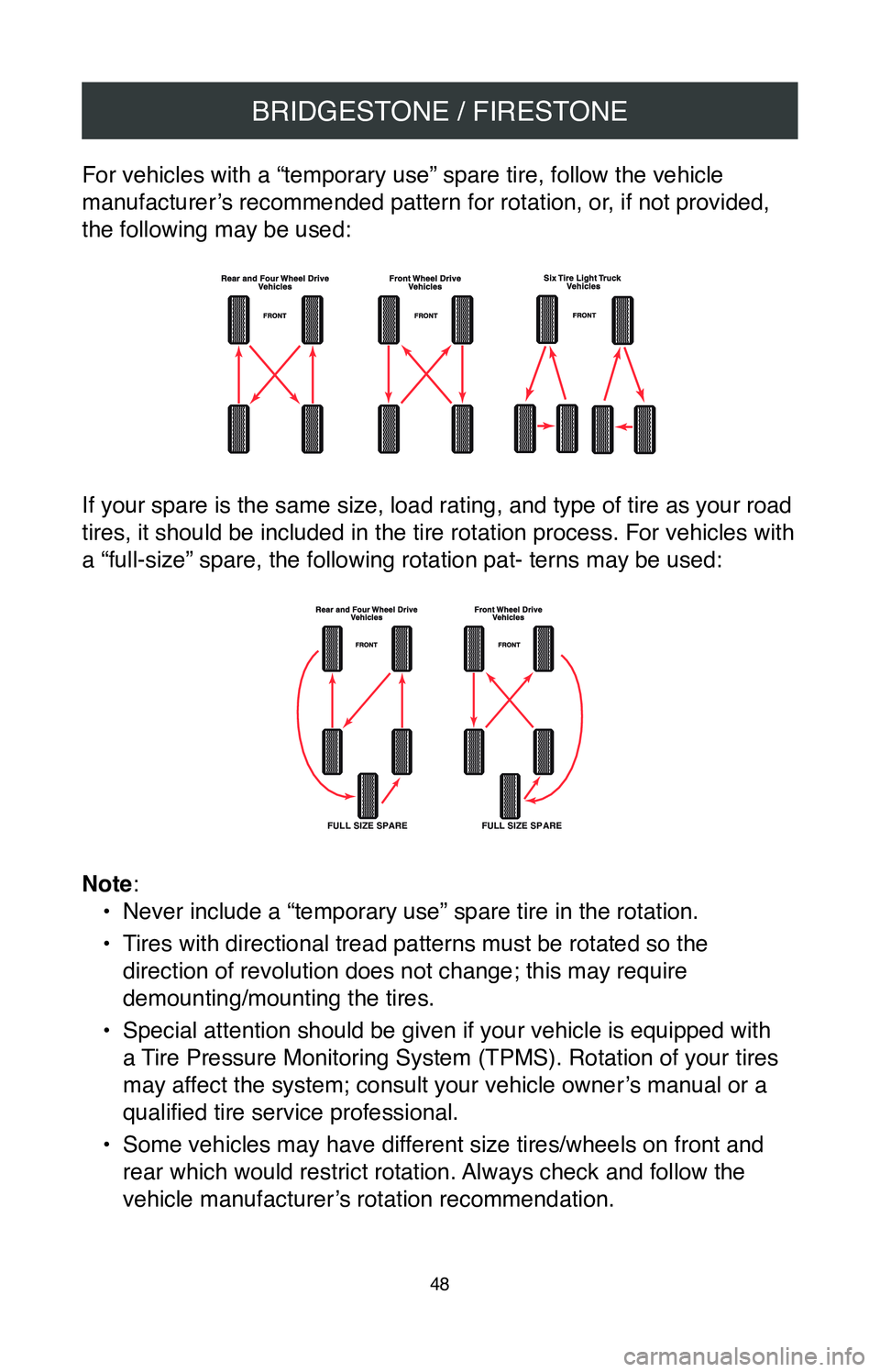
BRIDGESTONE / FIRESTONE
48
For vehicles with a “temporary use” spare tire, follow the vehicle\
manufacturer’s recommended pattern for rotation, or, if not provided,
the following may be used:
If your spare is the same size, load rating, and type of tire as your ro\
ad
tires, it should be included in the tire rotation process. For vehicles \
with
a “full-size” spare, the following rotation pat- terns may be used:
FULL SIZE SPAREFULL SIZE SPARE
Note:
•
Never include a “temporary use” spare tire in the rotation.
•
Tires with directional tread patterns must be rotated so the
direction of revolution does not change; this may require
demounting/mounting the tires.
•
Special attention should be given if your vehicle is equipped with
a Tire Pressure Monitoring System (TPMS). Rotation of your tires
may affect the system; consult your vehicle owner’s manual or a
qualified tire service professional.
•
Some vehicles may have different size tires/wheels on front and
rear which would restrict rotation. Always check and follow the
vehicle manufacturer’s rotation recommendation.
Page 54 of 260
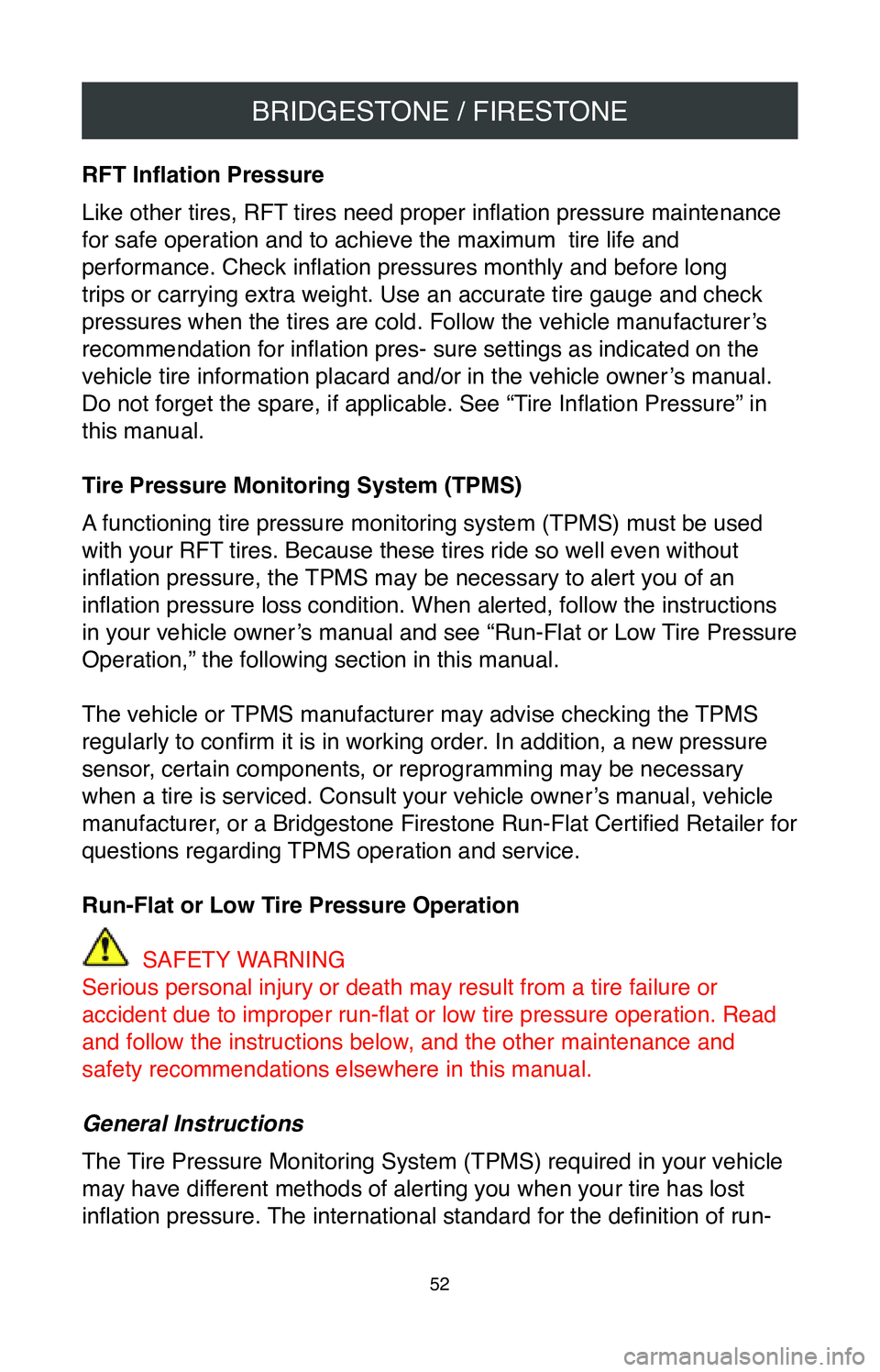
BRIDGESTONE / FIRESTONE
52
RFT Inflation Pressure
Like other tires, RFT tires need proper inflation pressure maintenance
for safe operation and to achieve the maximum tire life and
performance. Check inflation pressures monthly and before long
trips or carrying extra weight. Use an accurate tire gauge and check
pressures when the tires are cold. Follow the vehicle manufacturer’s
recommendation for inflation pres- sure settings as indicated on the
vehicle tire information placard and/or in the vehicle owner’s manual.
Do not forget the spare, if applicable. See “Tire Inflation Pressure” in
this manual.
Tire Pressure Monitoring System (TPMS)
A functioning tire pressure monitoring system (TPMS) must be used
with your RFT tires. Because these tires ride so well even without
inflation pressure, the TPMS may be necessary to alert you of an
inflation pressure loss condition. When alerted, follow the instructions
in your vehicle owner’s manual and see “Run-Flat or Low Tire Pressure
Operation,” the following section in this manual.
The vehicle or TPMS manufacturer may advise checking the TPMS
regularly to confirm it is in working order. In addition, a new pressure
sensor, certain components, or reprogramming may be necessary
when a tire is serviced. Consult your vehicle owner’s manual, vehicle
manufacturer, or a Bridgestone Firestone Run-Flat Certified Retailer for
questions regarding TPMS operation and service.
Run-Flat or Low Tire Pressure Operation
SAFETY WARNING
Serious personal injury or death may result from a tire failure or
accident due to improper run-flat or low tire pressure operation. Read
and follow the instructions below, and the other maintenance and
safety recommendations elsewhere in this manual.
General Instructions
The Tire Pressure Monitoring System (TPMS) required in your vehicle
may have different methods of alerting you when your tire has lost
inflation pressure. The international standard for the definition of run-
Page 55 of 260
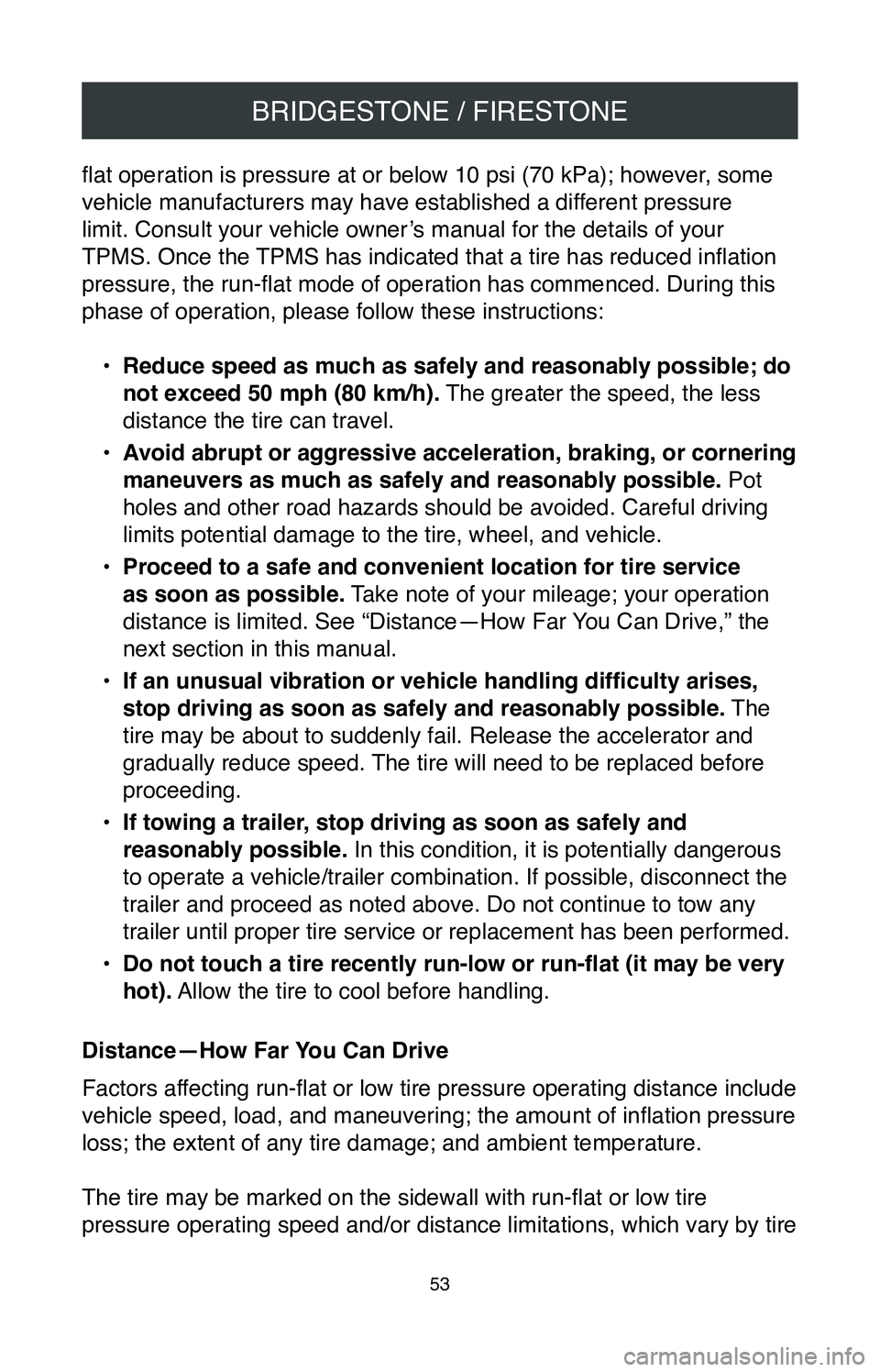
BRIDGESTONE / FIRESTONE
53
flat operation is pressure at or below 10 psi (70 kPa); however, some
vehicle manufacturers may have established a different pressure
limit. Consult your vehicle owner’s manual for the details of your
TPMS. Once the TPMS has indicated that a tire has reduced inflation
pressure, the run-flat mode of operation has commenced. During this
phase of operation, please follow these instructions:•
Reduce speed as much as safely and reasonably possible; do
not exceed 50 mph (80 km/h). The greater the speed, the less
distance the tire can travel.
•
Avoid abrupt or aggressive acceleration, braking, or cornering
maneuvers as much as safely and reasonably possible. Pot
holes and other road hazards should be avoided. Careful driving
limits potential damage to the tire, wheel, and vehicle.
•
Proceed to a safe and convenient location for tire service
as soon as possible. Take note of your mileage; your operation
distance is limited. See “Distance—How Far You Can Drive,” the
next section in this manual.
•
If an unusual vibration or vehicle handling difficulty arises,
stop driving as soon as safely and reasonably possible. The
tire may be about to suddenly fail. Release the accelerator and
gradually reduce speed. The tire will need to be replaced before
proceeding.
•
If towing a trailer, stop driving as soon as safely and
reasonably possible. In this condition, it is potentially dangerous
to operate a vehicle/trailer combination. If possible, disconnect the
trailer and proceed as noted above. Do not continue to tow any
trailer until proper tire service or replacement has been performed.
•
Do not touch a tire recently run-low or run-flat (it may be very
hot). Allow the tire to cool before handling.
Distance—How Far You Can Drive
Factors affecting run-flat or low tire pressure operating distance include
vehicle speed, load, and maneuvering; the amount of inflation pressure
loss; the extent of any tire damage; and ambient temperature.
The tire may be marked on the sidewall with run-flat or low tire
pressure operating speed and/or distance limitations, which vary by tire\
Page 56 of 260
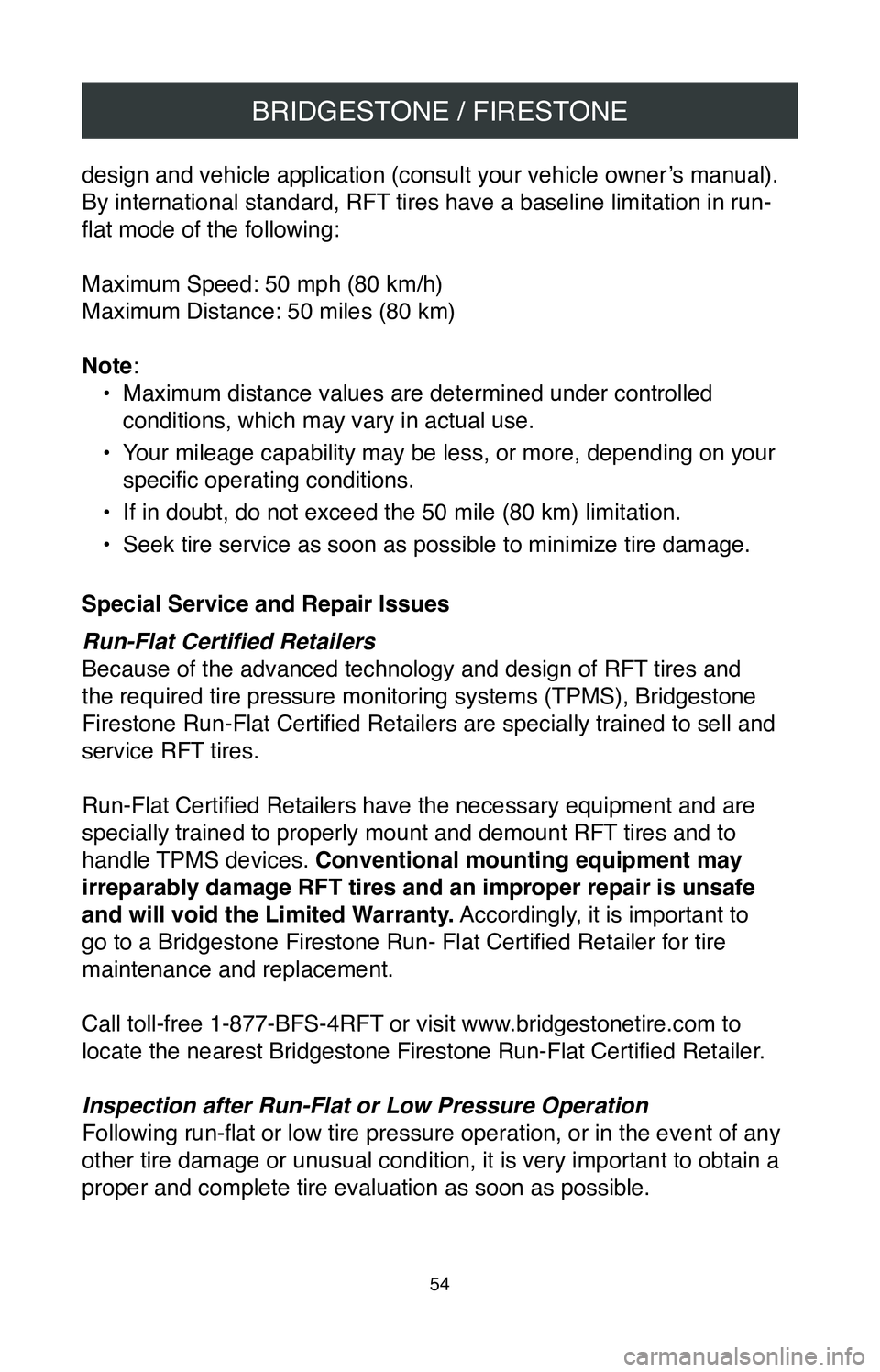
BRIDGESTONE / FIRESTONE
54
design and vehicle application (consult your vehicle owner’s manual).
By international standard, RFT tires have a baseline limitation in run-
flat mode of the following:
Maximum Speed: 50 mph (80 km/h)
Maximum Distance: 50 miles (80 km)
Note:•
Maximum distance values are determined under controlled
conditions, which may vary in actual use.
•
Your mileage capability may be less, or more, depending on your
specific operating conditions.
•
If in doubt, do not exceed the 50 mile (80 km) limitation.
•
Seek tire service as soon as possible to minimize tire damage.
Special Service and Repair Issues
Run-Flat Certified Retailers
Because of the advanced technology and design of RFT tires and
the required tire pressure monitoring systems (TPMS), Bridgestone
Firestone Run-Flat Certified Retailers are specially trained to sell and
service RFT tires.
Run-Flat Certified Retailers have the necessary equipment and are
specially trained to properly mount and demount RFT tires and to
handle TPMS devices. Conventional mounting equipment may
irreparably damage RFT tires and an improper repair is unsafe
and will void the Limited Warranty. Accordingly, it is important to
go to a Bridgestone Firestone Run- Flat Certified Retailer for tire
maintenance and replacement.
Call toll-free 1-877-BFS-4RFT or visit www.bridgestonetire.com to
locate the nearest Bridgestone Firestone Run-Flat Certified Retailer .
Inspection after Run-Flat or Low Pressure Operation
Following run-flat or low tire pressure operation, or in the event of any
other tire damage or unusual condition, it is very important to obtain a\
proper and complete tire evaluation as soon as possible.
Page 57 of 260
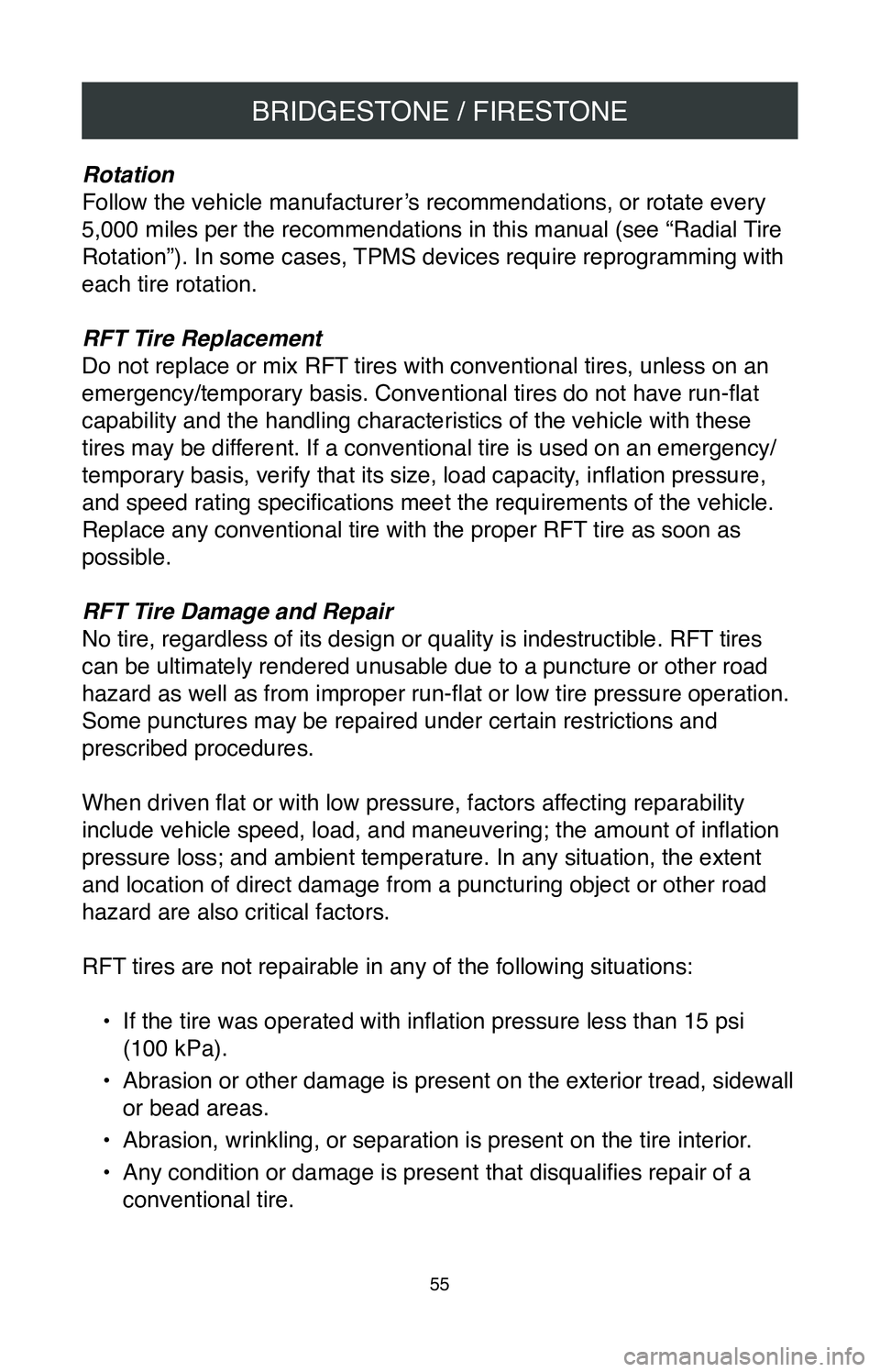
BRIDGESTONE / FIRESTONE
55
Rotation
Follow the vehicle manufacturer’s recommendations, or rotate every
5,000 miles per the recommendations in this manual (see “Radial Tire
Rotation”). In some cases, TPMS devices require reprogramming with
each tire rotation.
RFT Tire Replacement
Do not replace or mix RFT tires with conventional tires, unless on an
emergency/temporary basis. Conventional tires do not have run-flat
capability and the handling characteristics of the vehicle with these
tires may be different. If a conventional tire is used on an emergency/
temporary basis, verify that its size, load capacity, inflation pressure,
and speed rating specifications meet the requirements of the vehicle.
Replace any conventional tire with the proper RFT tire as soon as
possible.
RFT Tire Damage and Repair
No tire, regardless of its design or quality is indestructible. RFT tires
can be ultimately rendered unusable due to a puncture or other road
hazard as well as from improper run-flat or low tire pressure operation.
Some punctures may be repaired under certain restrictions and
prescribed procedures.
When driven flat or with low pressure, factors affecting reparability
include vehicle speed, load, and maneuvering; the amount of inflation
pressure loss; and ambient temperature. In any situation, the extent
and location of direct damage from a puncturing object or other road
hazard are also critical factors.
RFT tires are not repairable in any of the following situations:
•
If the tire was operated with inflation pressure less than 15 psi
(100 kPa).
•
Abrasion or other damage is present on the exterior tread, sidewall
or bead areas.
•
Abrasion, wrinkling, or separation is present on the tire interior.
•
Any condition or damage is present that disqualifies repair of a
conventional tire.
Page 78 of 260
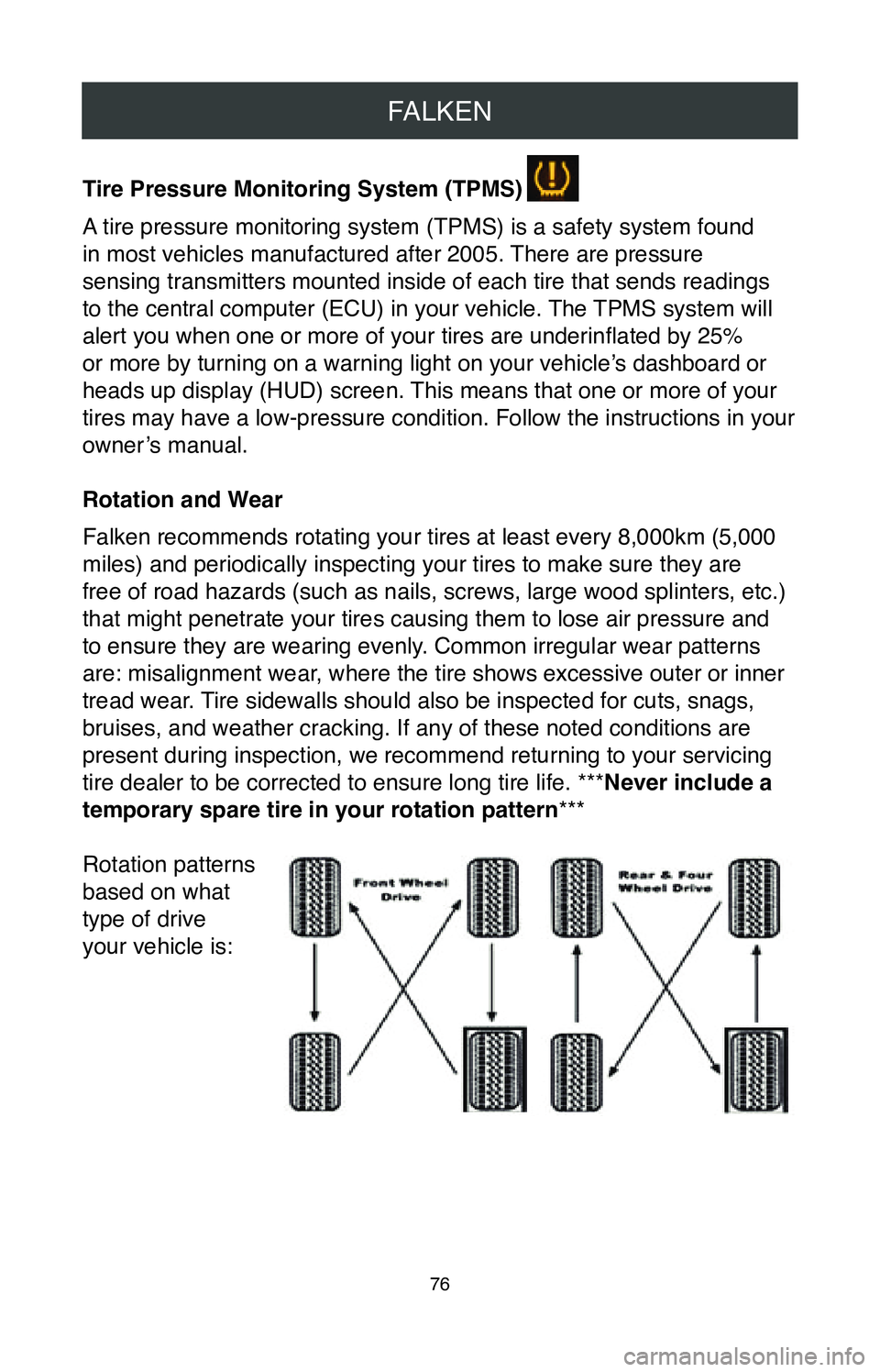
FALKEN
76
Tire Pressure Monitoring System (TPMS)
A tire pressure monitoring system (TPMS) is a safety system found
in most vehicles manufactured after 2005. There are pressure
sensing transmitters mounted inside of each tire that sends readings
to the central computer (ECU) in your vehicle. The TPMS system will
alert you when one or more of your tires are underinflated by 25%
or more by turning on a warning light on your vehicle’s dashboard or
heads up display (HUD) screen. This means that one or more of your
tires may have a low-pressure condition. Follow the instructions in your
owner’s manual.
Rotation and Wear
Falken recommends rotating your tires at least every 8,000km (5,000
miles) and periodically inspecting your tires to make sure they are
free of road hazards (such as nails, screws, large wood splinters, etc.)
that might penetrate your tires causing them to lose air pressure and
to ensure they are wearing evenly. Common irregular wear patterns
are: misalignment wear, where the tire shows excessive outer or inner
tread wear. Tire sidewalls should also be inspected for cuts, snags,
bruises, and weather cracking. If any of these noted conditions are
present during inspection, we recommend returning to your servicing
tire dealer to be corrected to ensure long tire life. ***Never include a
temporary spare tire in your rotation pattern***
Rotation patterns
based on what
type of drive
your vehicle is:
Page 129 of 260
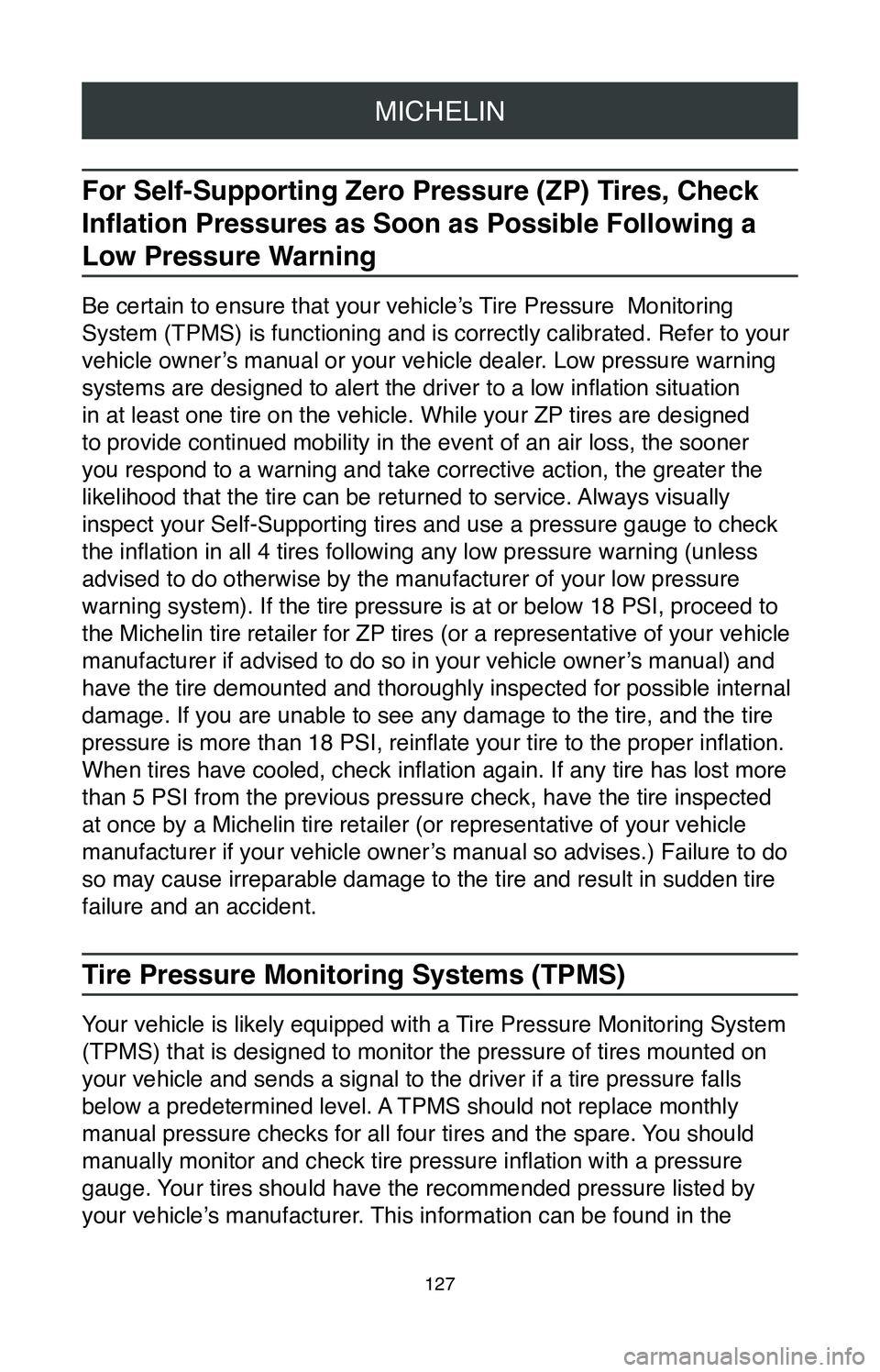
MICHELIN
127
For Self-Supporting Zero Pressure (ZP) Tires, Check
Inflation Pressures as Soon as Possible Following a
Low Pressure Warning
Be certain to ensure that your vehicle’s Tire Pressure Monitoring
System (TPMS) is functioning and is correctly calibrated. Refer to your
vehicle owner’s manual or your vehicle dealer. Low pressure warning
systems are designed to alert the driver to a low inflation situation
in at least one tire on the vehicle. While your ZP tires are designed
to provide continued mobility in the event of an air loss, the sooner
you respond to a warning and take corrective action, the greater the
likelihood that the tire can be returned to service. Always visually
inspect your Self-Supporting tires and use a pressure gauge to check
the inflation in all 4 tires following any low pressure warning (unless
advised to do otherwise by the manufacturer of your low pressure
warning system). If the tire pressure is at or below 18 PSI, proceed to\
the Michelin tire retailer for ZP tires (or a representative of your vehicle
manufacturer if advised to do so in your vehicle owner’s manual) and
have the tire demounted and thoroughly inspected for possible internal
damage. If you are unable to see any damage to the tire, and the tire
pressure is more than 18 PSI, reinflate your tire to the proper inflation.
When tires have cooled, check inflation again. If any tire has lost more
than 5 PSI from the previous pressure check, have the tire inspected
at once by a Michelin tire retailer (or representative of your vehicle
manufacturer if your vehicle owner’s manual so advises.) Failure to do
so may cause irreparable damage to the tire and result in sudden tire
failure and an accident.
Tire Pressure Monitoring Systems (TPMS)
Your vehicle is likely equipped with a Tire Pressure Monitoring System
(TPMS) that is designed to monitor the pressure of tires mounted on
your vehicle and sends a signal to the driver if a tire pressure falls
below a predetermined level. A TPMS should not replace monthly
manual pressure checks for all four tires and the spare. You should
manually monitor and check tire pressure inflation with a pressure
gauge. Your tires should have the recommended pressure listed by
your vehicle’s manufacturer. This information can be found in the